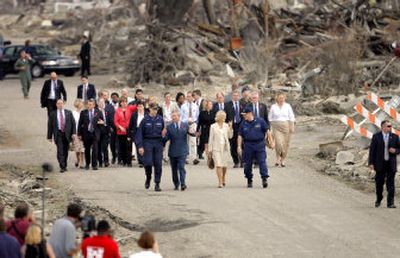Feds ease eligibility rules for aid from Hurricane Katrina

WASHINGTON – Faced with the daunting task of inspecting hundreds of thousands of damaged homes, federal officials have decided to award the maximum relief aid possible to people in neighborhoods presumed destroyed by Hurricane Katrina.
The Federal Emergency Management Agency has begun notifying 60,000 renters and property owners in nine Louisiana and Mississippi parishes and counties that they will immediately receive as much as $26,200, the most Congress has authorized for individual households battered by Katrina. The determination of who gets the money is being based on satellite imagery of the worst flooding or wind damage, broken down by ZIP code, where individual inspections have not been done.
Although it may be possible that some homes in those areas escaped serious damage and their owners do not require the aid, FEMA has decided not to wait for case-by-case inspections.
“It is presumed these homes are uninhabitable, and these persons will be eligible for the maximum amount they can receive,” said FEMA spokeswoman Nicol Andrews. “Basically if you lived here … if you lost everything you owned, which is presumable, you’ll probably receive the $26,200,” though renters will receive less.
The move was not formally announced by FEMA but will complete the agency’s cash obligation to a large number of victims of Katrina, which hit on Aug. 29. With the onset of cold weather, officials have estimated that as many as 600,000 families require long-term housing. The agency’s multibillion-dollar plans to temporarily place people aboard cruise ships, in hotels, mobile homes or trailers have been criticized as wasteful and ill-conceived.
The aid would not be discounted by any money for hotels FEMA is paying for 200,000 residents who fled the storm. But it would be offset by any other FEMA cash aid – including rental assistance for apartments – those people may be receiving. The affected nine-digit ZIP codes are in Orleans, Jefferson, St. Bernard, St. Charles and Plaquemines parishes in Louisiana, and Jackson, Harrison and Hancock counties in Mississippi.
FEMA said Friday that its estimated cost in Louisiana alone will be $41.4 billion, about five times what it spent on the Sept. 11, 2001, terrorist attack in New York. The state’s share would be $3.7 billion – the equivalent of about half of Louisiana’s state annual general fund.
So far, 2.8 million households have applied for federal aid from Katrina and from Hurricane Rita, which struck the Texas and Louisiana coast three weeks later, Andrews said. Based on past disasters, about two-thirds will qualify for help.
The $26,200 is the most money homeowners can receive. There are eligibility limits and restrictions on what the money can be spent on, but it can pay for home repairs, for temporary housing and to replace a car.
House inspections are continuing outside the devastated areas covered by FEMA’s decision. Officials are scrambling to find adequate housing for those people in hotels, with the goal of having all of them out by Dec. 1. The apartment assistance program for 496,000 families begins to phase out on Dec. 23 though FEMA could decide to extend some individuals.
Barbara Sard, housing policy director for the Center on Budget and Policy Priorities, said the Bush administration last week dedicated $390 million to move as many as 65,000 Katrina families who were homeless or in public housing before the storm into the Section 8 low-income rental assistance voucher program, a change advocates had sought.
Sard encouraged the White House to convert apartment assistance program into a similar voucher program. “How can you make case-by-case decisions on 400,000 people without making wildly different results for similarly situated people?” Sard said. “How is that fair and how can anyone plan, recognizing you’ve got a very difficult situation?”
FEMA used such a voucher program to house 22,000 families displaced by the 1994 Northridge Earthquake near Los Angeles at a cost of $200 million.